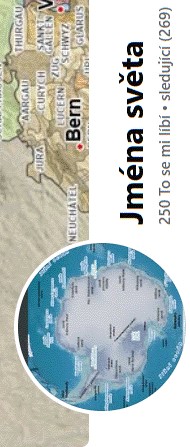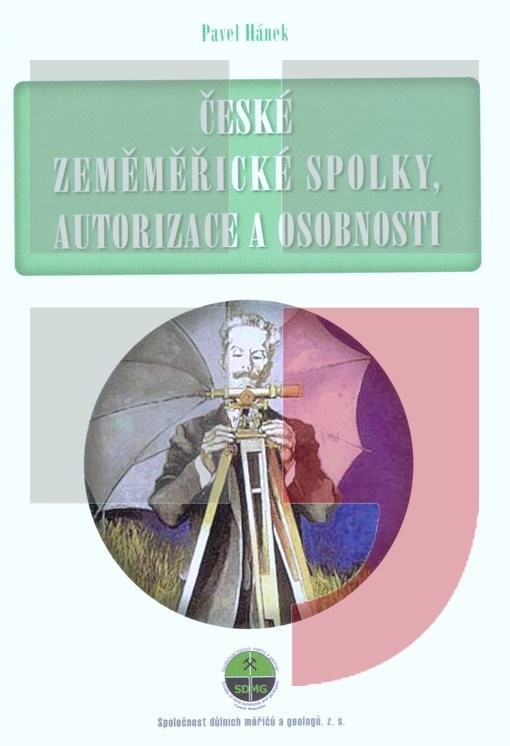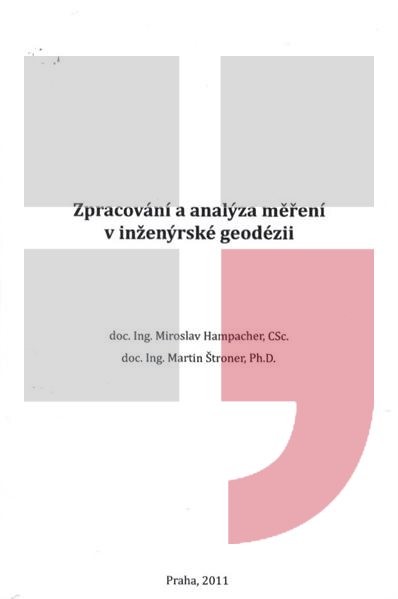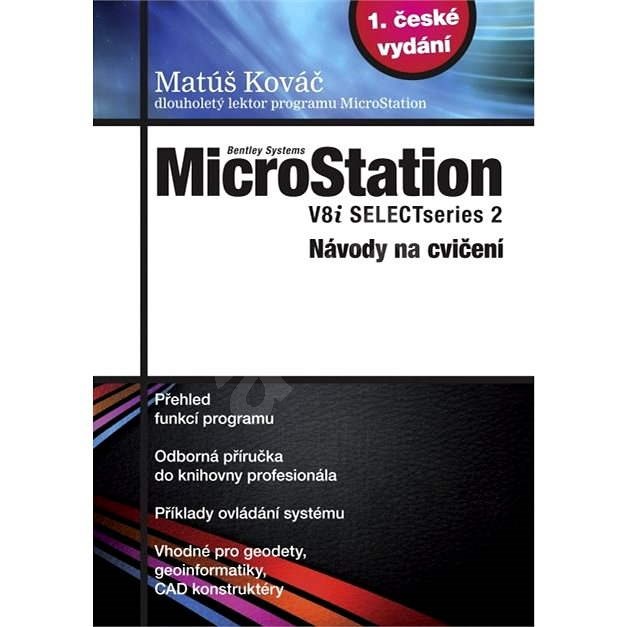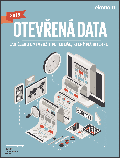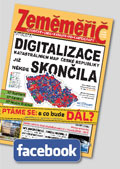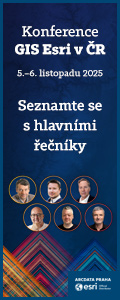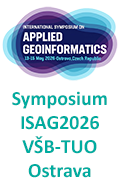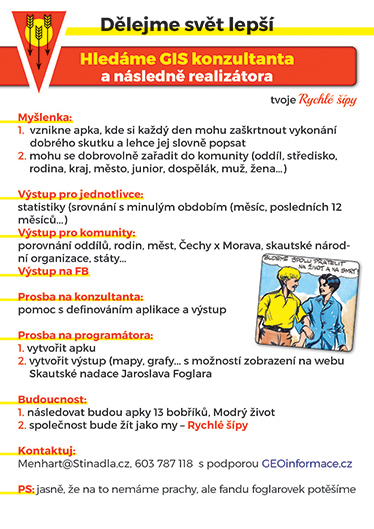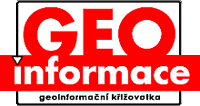zprávy
zdroje zpráv:Prodej motorových 2 ks vozidel Škoda Octavia
16.2.2017 14:40 ČÚZK - předpisy a opatřeníČeský úřad zeměměřický a katastrální nabízí nepotřebný majetek k odkupu. Jedná se o prodej motorových 2 ks vozidel Škoda Octavia
Prodej motorových 2 ks vozidel Škoda Octavia
Prodej motorových 2 ks vozidel Škoda Octavia
16.2.2017 14:40 ČÚZK /Urady/Cesky-urad-zememericky-a-katastralni/Nabidka-majetku/Prodej-motorovych-2-ks-vozidel-Skoda-OctaviaEarth from Space
16.2.2017 14:30 ESA Observing the Earth
Join us Friday, 17 February, at 10:00 CET for the ‘Earth from Space’ video programme. The Ötztal Alps in the western Austrian state of Tyrol are featured in this week’s edition
Earth from Space
16.2.2017 14:30 ESA Observing the Earth
Join us Friday, 17 February, at 10:00 CET for the ‘Earth from Space’ video programme. The Ötztal Alps in the western Austrian state of Tyrol are featured in this week’s edition
Do evidence Územně analytickýc
16.2.2017 12:00 Jihočeský kraj Do evidence Územně analytických podkladů ORP byly přidány dokumentace IV. aktualizací ÚAP následujících ORP: Třeboň, Milevsko, Kaplice a Prachatice.V mapové aplikaci Územně pláno
16.2.2017 12:00 Jihočeský kraj V mapové aplikaci Územně plánovací dokumentace obcí byla aktualizována územně plánovací dokumentace obcí Borovany (Trhové Sviny) a Týn nad Vltavou. Nově pak byla přidána územně plánovací dokumentace obcí Jickovice a Písek.V mapové aplikaci byla aktual
16.2.2017 12:00 Jihočeský kraj V mapové aplikaci byla aktualizována územně plánovací dokumentace obcí Borovany (Trhové sviny) a Týn nad Vltaou. Nově pak byla přidána územně plánovací dokumentace obcí Jickovice a Písek.V mapové aplikaci byla aktual
16.2.2017 12:00 Jihočeský kraj V mapové aplikaci byla aktualizována územně plánovací dokumentace obcí Borovany (Trhové Sviny) a Týn nad Vltavou. Nově pak byla přidána územně plánovací dokumentace obcí Jickovice a Písek.Do evidence Územně analytickýc
16.2.2017 12:00 Jihočeský kraj Do evidence Územně analytických podkladů ORP (http://geoportal.kraj-jihocesky.gov.cz/gs/uzemne-analyticke-podklady-orp/) byly přidány dokumentace IV. aktualizací ÚAP následujících ORP: Třeboň, Milevsko, Kaplice a Prachatice.EGNOS can crack the capacity crunch!
16.2.2017 11:20 European GNSS Agency
Tackling the looming airspace and airport capacity crunch is one of the main challenges facing the growth of European aviation. But global navigation satellite systems (GNSS), such as the European Geostationary Navigation Overlay Service (EGNOS) and Galileo, can provide the key to increased capacity. This was the focus of the European Business Aviation Association’s (EBAA) annual debate at the European Parliament on 9 February, where the European GNSS Agency (GSA) participated.
The event, entitled ‘Tackling the capacity crunch: satellite-based technologies to the rescue’, was hosted at the European Parliament by Marian-Jean Marinescu, MEP – a leading member of the European Parliament’s Committee on Transport and Tourism. He emphasized the importance of EGNOS in opening up capacity and looked forward to the full deployment of GNSS applications, with special focus on the use of EGNOS for navigation and surveillance (ADS-B). Fabio Gamba, the CEO of EBAA, called for “an overall CNS Strategy (Navigation, Com, Surveillance), which includes a revision of the Single European Sky technical mandates”. In this regard, “EBAA is willing to pursue its cooperation with the GSA established under an MoU signed in 2014,” added Gamba. He highlighted the need for Europe to optimize its current capacity as no major new airports would be built in the near future. He stated that Galileo and EGNOS have the “potential to be a game changer” and that “EGNOS can put hundreds of regional and tertiary airports on the map”. This would free up capacity at major hub airports.
Increased accessibility
Spanish MEP Ines Ayala-Sender supported the message stating “Satellite technology could liberate capacity in major hubs while increasing accessibility to regional airports,” and argued that there is a need for a “united approach and overall navigation strategy”.
Paul Flament, Head of Unit for the Galileo/EGNOS programme at the European Commission’s DG GROW reminded the audience that “EGNOS was specifically conceived for the aviation sector” and had been operational since 2011. There are now more than 400 approach procedures in some 20 countries and the performance is excellent. The remaining small areas without coverage in northern Finland and Romania should be completed by 2018 with full localiser performance with vertical guidance (LPV) 200 performance available across the whole of the EU by 2023.
He confirmed that EGNOS technology was also attracting attention outside the EU. Agreements with the Agency for Air Navigation Safety in Africa and Madagascar (ASECNA) were likely to be signed soon to extend EGNOS over Africa. EGNOS technology had also been purchased by South Korea.
Cost savings
The GSA’s Head of Market Development Gian-Gherardo Calini acknowledged that business aviation is a key market segment for EGNOS. He highlighted the benefits of EGNOS to increase accessibility and safety, and highlighted its potential to reduce congestion in the system. “EGNOS can reduce diversions and cancellations, delivering real cost savings,” he claimed. EGNOS also enables advanced approaches, such as curved segments, resulting in environmental benefits.
Mr Calini was pleased with progress in the EU, pointing out that 25% of business aviation flights are already equipped for LPV, only six years after EGNOS certification. The figure is very close to that in the US, with 32% equipped flights for air taxi operations after 14 years of WAAS operations. He anticipated a further 200 LPV procedures already planned to be operational in the next two years.
The final speaker was Pascal Lhoest, Director of Flight Operations at NetJets Europe. He argued that poor ground installations at airports was a barrier to safe business aviation operations. EGNOS offers the opportunity for business aviation to reach into regional airports and improve access in complex air traffic management environments. The key was getting “the right access to the right airports” and EGNOS is fundamental to achieving this.
Media note: This feature can be republished without charge provided the European GNSS Agency (GSA) is acknowledged as the source at the top or the bottom of the story. You must request permission before you use any of the photographs on the site. If you republish, we would be grateful if you could link back to the GSA website (http://www.gsa.europa.eu).
Mapa dopravních nehod v Plzeňském kraji má aktuální data za rok 2016 (TZ)
16.2.2017 10:22 GISportal.cz Aktualizovaná verze mapy, která zobrazuje dopravní nehodovost na silnicích v Plzeňském kraji je od února k dispozici na webu. Policie tímto způsobem analyzuje nehodovost v Plzeňském kraji již od roku 2012 v rámci ojedinělého pilotního projektu. Webovou mapovou službu připravil ...Drought to overflow
16.2.2017 10:19 ESA Observing the Earth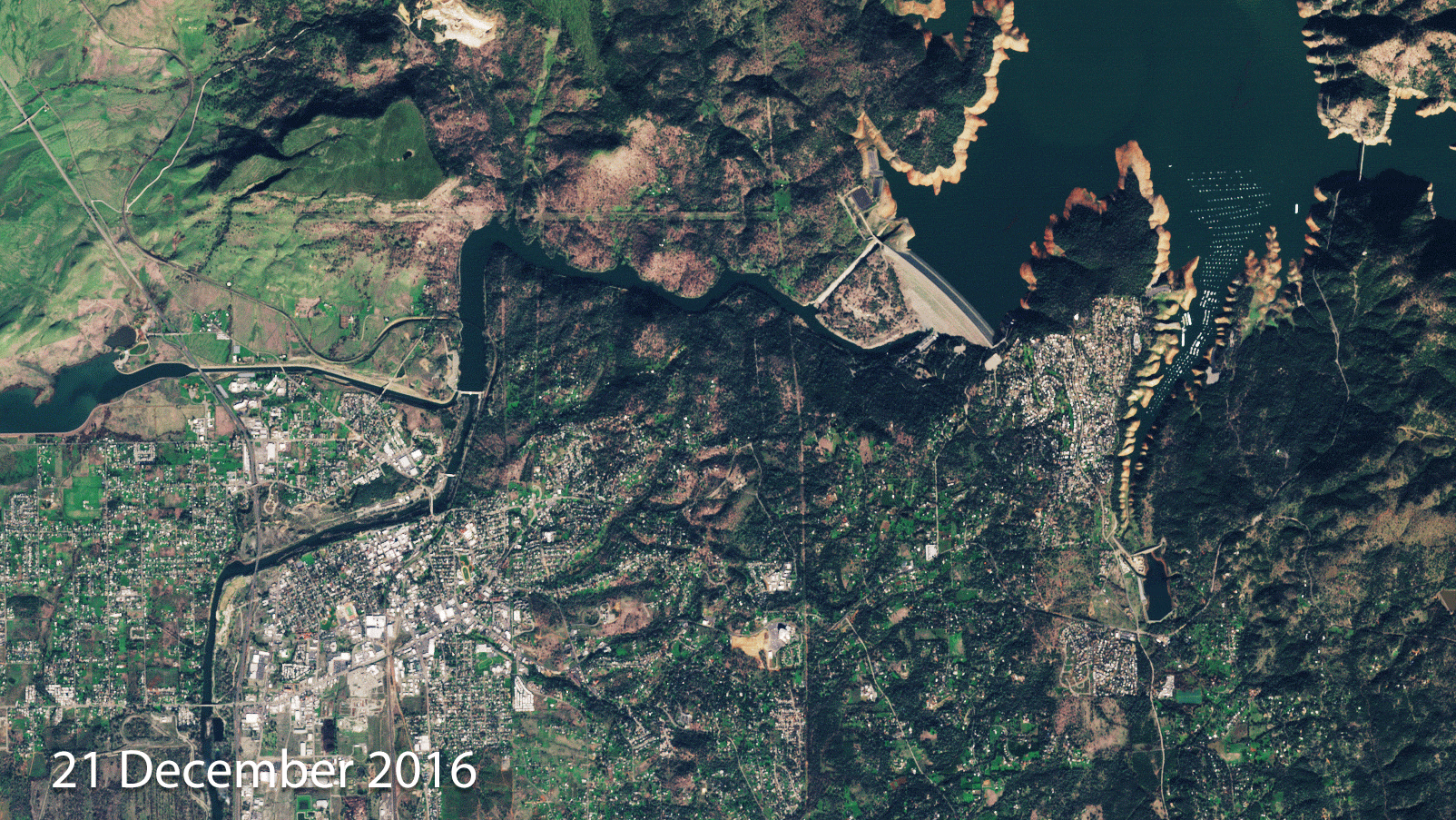
Images from Sentinel-2A show how extraordinarily wet weather caused waters to overflow California’s highest dam
Sentinel-2 teams prepare for space
16.2.2017 9:30 ESA Observing the Earth
Going to space is never routine, and Sentinel-2 mission controllers are leaving nothing to chance as they prepare for the critical days following next month’s liftoff.
Fuel Sentinel-2B: done
16.2.2017 9:05 ESA Observing the Earth
As liftoff day draws closer, the Sentinel-2B ‘to do list’ list is shrinking as tasks are ticked off, including the tricky process of fuelling the satellite. And, even despite having to do a few unexpected jobs, everything is on track for launch.
Fuel Sentinel-2B: done
16.2.2017 9:05 ESA Observing the Earth
As liftoff day draws closer, the Sentinel-2B 'to do' list is shrinking as tasks are ticked off, including the tricky process of fuelling the satellite. And, even despite having to do a few unexpected jobs, everything is on track for launch.
2016
16.2.2017 8:56 ČÚZK /Urady/Katastralni-urady/Katastralni-urady/Katastralni-urad-pro-Zlinsky-kraj/Casto-hledane-informace/Poskytovani-informaci-106-1999-Sb/Zverejneni-obsahu-informaci-poskytnutych-na-za-(1)/(1)2016
16.2.2017 8:56 ČÚZK - předpisy a opatření Katastrální úřad pro Zlínský krajzveřejňuje obsah informace poskytnutých na žádost dle zákona č. 106/1999 Sb. za rok 2016
2016
2016
16.2.2017 8:48 ČÚZK - předpisy a opatření Katastrální úřad pro Zlínský krajvydává výroční zprávu úřadu za rok 2016
2016
2016
16.2.2017 8:48 ČÚZK /Urady/Katastralni-urady/Katastralni-urady/Katastralni-urad-pro-Zlinsky-kraj/Vyrocni-zpravy/2016Síť stanic povrchových vod - průtoky
16.2.2017 1:00 Cenia - Katalog metadat ČR - INSPIRE Vrstva umístění vodoměrných stanicVíce než 90% měření se provádí pomocí automatických stanic, a to buď smístním záznamem nebo s dálkovým přenosem. Pozorované vodní stavy se převádějí na průtoky pomocí měrných křivek, které se stanovují na základě hydrometrických měření.Data z těchto stanic se ukládají do Centrální režimové databáze množství povrchových vod, kterou spravuje oddělení Hydrofondu a bilancí.První start rakety Ariane 5 v letošním roce
15.2.2017 15:48 Český Kosmický PortálRaketa Ariane 5, kterou provozuje společnost Arianespace, dopravila na plánované oběžné dráhy telekomunikační družice Sky Brasil-1 a Telkom-3S.
První start rakety Ariane 5 v letošním roce
15.2.2017 15:48 Český Kosmický PortálRaketa Ariane 5, kterou provozuje společnost Arianespace, dopravila na plánované oběžné dráhy telekomunikační družice Sky Brasil-1 a Telkom-3S.
odborný rada – inspektor Zeměměřického a katastrálního inspektorátu v Pardubicích
15.2.2017 12:43 ČÚZK - volná místa Zeměměřický a katastrální inspektorát v Pardubicích, vypisuje výběrové řízení na místo odborný rada – inspektor Zeměměřického a katastrálního inspektorátu v Pardubicíchodborný rada – inspektor Zeměměřického a katastrálního inspektorátu v Pardubicích
15.2.2017 12:43 ČÚZK /Urady/Zememericke-a-katastralni-inspektoraty/Zememericke-a-katastralni-inspektoraty/Zememericky-a-katastralni-inspektorat-v-Pardubicic/Uredni-deska/Oznameni-a-jina-uredni-sdeleni/Volna-mista/odborny-rada-–-inspektor-Zememerickeho-a-katastralodborný rada – inspektor Zeměměřického a katastrálního inspektorátu v Pardubicích
15.2.2017 12:43 ČÚZK - předpisy a opatření Zeměměřický a katastrální inspektorát v Pardubicíchvypisuje výběrové řízení na místo
odborný rada – inspektor Zeměměřického a katastrálního inspektorátu v Pardubicích
Príliš veľké očakávania
15.2.2017 12:21 Komora pozemkových úprav SRSnaha zmeniť ústavu a dostať slovo pôda do ústavy je nepochybne cieľom, ktorý má všetky znaky vlastenectva, hrdosti a lásky k našej krajine. Ale postaviť sa za túto zmenu vyžaduje trocha opatrnosti a prezieravosti. To ako sa bude štát správať voči tým,...
Natáčeli jsme v Dukovanech jadernou elektrárnu pro chystaný dokument Brněnské hvězdárny
15.2.2017 9:39 UpVision S východem slunce jsme v pondělí zahájili letový den u Jaderné elektrárny Dukovany. Celý zakázaný prostor LKP9 byl od toho okamžiku jen náš a náležitě jsme si to užili. Díky vstřícnosti a pečlivému dozoru pracovníků ostrahy elektrárny, skvělé spolupráci řídících na věži letiště Náměšť a výjimce od ÚCL jsme natočili další záběry ve spolupráci s Hvězdárnou a planetáriem Brno.Několik fotek zde:
https://plus.google.com/+UpvisionCz1/posts/8ekUjUcp35F
20170215-GaKO-2-2017
15.2.2017 9:35 ČÚZK - předpisy a opatření Aktuální číslo Geodetického a kartografického obzoru (2/2017) ke stažení zde.
Nové číslo GaKO
15.2.2017 9:15
ÚGKK SR
Nové číslo časopisu Geodetického a Kartografického Obzoru 02/2017
Referent vnitřní správy
15.2.2017 9:11 ČÚZK /Urady/Katastralni-urady/Katastralni-urady/Katastralni-urad-pro-Karlovarsky-kraj/Volna-mista/Referent-vnitrni-spravyReferent vnitřní správy
15.2.2017 9:11 ČÚZK - předpisy a opatření Katastrální úřad pro Karlovarský krajvypisuje výběrové řízení na místo
Referent vnitřní správy
Referent vnitřní správy
15.2.2017 9:11 ČÚZK - volná místa Katastrální úřad pro Karlovarský kraj, vypisuje výběrové řízení na místo Referent vnitřní správyNabídka pracovní pozice v Mapové sbírce PřF UK
15.2.2017 7:00 Česká asociace pro geoinformaceMapová sbírka PřF UK přijme zástup za mateřskou dovolenou na pozici knihovník-bibliograf
Aktuální nabídka pracovní pozice v jedinečném prostředí Mapové sbírky pro zájemce z řad knihovníků, archivářů, kartografů, geografů.
Pracovní náplň: odborná katalogizace, výpůjční protokol, exkurze, administrativa, organizace a správa cenných sbírek, editace
25 let od prvního českého připojení k internetu
15.2.2017 7:00 Česká asociace pro geoinformace 13. února 1992, se studentům a učitelům z pražské ČVUT podařilo připojit do sítě internet. Šlo o první takové spojení z Československa, velkou zásluhu na tom má sálový počítač IBM o rozměrech 10 x 30 metrů, který k tomu posloužil.Díky přenosové rychlosti 19 kBit/s se přes tuto síť podařilo odeslat několik textových elektronických zpráv, nahrazujících
Oznámení o vyhlášení výběrového řízení na služební místo rada/odborný rada Pobočka Kolín
15.2.2017 0:00 Státní pozemkový úřad Ústřední ředitelka Státního pozemkového úřadu, jako služební orgán příslušný podle § 10 odst. 1 písm. f) zákona č. 234/2014 Sb., o státní službě (dále jen „zákon“), vyhlašuje výběrové řízení na služební místo rada/odborný rada Pobočka Kolín.Oznámení o vyhlášení výběrového řízení na služební místo odborný rada oddělení metodiky VHS 2
15.2.2017 0:00 Státní pozemkový úřad Ústřední ředitelka Státního pozemkového úřadu, jako služební orgán příslušný podle § 10 odst. 1 písm. f) zákona č. 234/2014 Sb., o státní službě (dále jen „zákon“), vyhlašuje výběrové řízení na služební místo odborný rada oddělení metodiky VHS.Vyjádření SPÚ k ukončení šetření ve věci jmenování Svatavy Maradové do funkce ústřední ředitelky
15.2.2017 0:00 Státní pozemkový úřad Policie ČR se přestala zabývat trestním oznámením z loňského léta, které se týkalo jmenování Svatavy Maradové do funkce ústřední ředitelky Státního pozemkového úřadu (SPÚ). Svým konstatováním, že se nestal žádný trestní čin tak policie potvrdila to, co Státní pozemkový úřad tvrdil od počátku - tedy že jde jen o vykonstruované obvinění, které nemá žádný právní základ a je namířeno zcela účelově proti ústřední ředitelce Svatavě Maradové.Oznámení o vyhlášení výběrového řízení na služební místo odborný rada oddělení majetkoprávních vztahů a rezervy, odbor správy majetku státu
15.2.2017 0:00 Státní pozemkový úřad Ústřední ředitelka Státního pozemkového úřadu, jako služební orgán příslušný podle § 10 odst. 1 písm. f) zákona č. 234/2014 Sb., o státní službě (dále jen „zákon“), vyhlašuje výběrové řízení na služební místo odborný rada oddělení majetkoprávních vztahů a rezervy, odbor správy majetku státu.Oznámení o vyhlášení výběrového řízení na služební místo odborný rada oddělení metodiky VHS
15.2.2017 0:00 Státní pozemkový úřad Ústřední ředitelka Státního pozemkového úřadu, jako služební orgán příslušný podle § 10 odst. 1 písm. f) zákona č. 234/2014 Sb., o státní službě (dále jen „zákon“), vyhlašuje výběrové řízení na služební místo odborný rada oddělení metodiky VHS.Oznámení o vyhlášení výběrového řízení na služební místo vedoucí oddělení strategie a projektového řízení
15.2.2017 0:00 Státní pozemkový úřad Ústřední ředitelka Státního pozemkového úřadu, jako služební orgán příslušný podle § 10 odst. 1 písm. f) zákona č. 234/2014 Sb., o státní službě (dále jen „zákon“), vyhlašuje výběrové řízení na služební místo vedoucí oddělení strategie a projektového řízení.ISPRS e-bulletin: 2017 – Issue No.1
14.2.2017 22:34 Společnost pro fotogrammetrii a dálkový průzkumThe post ISPRS e-bulletin: 2017 – Issue No.1 appeared first on SFDP.
Družice monitorují sesuvy půdy v Alpách
14.2.2017 11:26 Český Kosmický PortálTání ledovců díky změnám klimatu způsobuje čím dál častěji sesuvy půdy v alpských oblastech. Data získávaná satelitní misí Sentinel-1 nyní byla nahrána do nového cloudového systémy, aby bylo možné podobná rizika monitorovat globálně.
Družice monitorují sesuvy půdy v Alpách
14.2.2017 11:26 Český Kosmický PortálTání ledovců díky změnám klimatu způsobuje čím dál častěji sesuvy půdy v alpských oblastech. Data získávaná satelitní misí Sentinel-1 nyní byla nahrána do nového cloudového systémy, aby bylo možné podobná rizika monitorovat globálně.
Nový předmět KGG/PIAP
14.2.2017 10:26 Katedra geografie UP Olomouc Nabídku předmětů od tohoto semestru rozšířil předmět KGG/PIAP Práce s informacemi a akademické psaní (dr. Frantál), který můžeme doporučit zejména studentům píšícím diplomovou práci a také všem dalším zájemcům o zdokonalení svých dovedností v práci s texty, se zdroji dat a informací apod.Upozornění (1)
14.2.2017 9:36 ČÚZK - předpisy a opatřeníUpozorňujeme, že fax na čísle: 327 551 224 je zrušen.
Upozornění (1)
14.2.2017 9:36 ČÚZK /Urady/Katastralni-urady/Katastralni-urady/Katastralni-urad-pro-Stredocesky-kraj/Katastralni-pracoviste/KP-Kutna-Hora/O-uradu/Aktuality/Upozorneni-(1)GNSS Market Report hits 40k downloads… and counting
14.2.2017 9:34 European GNSS Agency
In the fast evolving world of satellite navigation technology and GNSS applications, monitoring the landscape and having the latest information is essential. The GSA’s 2015 GNSS Market Report, which provides an in-depth look at market opportunities and technology trends across eight market segments, is the go-to resource for GNSS market intelligence, being cited by policy and strategy documents across the globe.
Since its launch on 25 March 2015, the fourth issue of the European GNSS Agency’s (GSA) GNSS Market Report has been downloaded over 40 000 times – proving its position as the go-to resource for global navigation satellite system (GNSS) market intelligence. Covering location-based services (LBS), road transportation, aviation, maritime, rail, agriculture, mapping and surveying, and timing and synchronisation, the report serves a wide variety of industries, private businesses, institutions and public stakeholders around the world.
Unique to this edition of the Market Report is an analysis of more than 300 receiver and chipset models available on the global market in 2015 – an important topic further explored in the 2016 GNSS User Technology Report. Published as a sister publication to the GNSS Market Report, the GNSS User Technology Report zeros in on the latest state-of-the-art GNSS receiver technology, along with providing expert analysis on the evolutionary trends that are set to redefine the global GNSS landscape. Topics include:
- mass-market solutions
- transport safety and liability-critical solutions
- high-precision, timing and asset management solutions.
“The GSA’s GNSS Market Report has been continuously improving over the years and, combined with the new GNSS User Technology Report, we can definitely say that it is a valuable source of information for our work,” says Telespazio France Head of SatNav Downstream Department Axelle Pomies. “Overall, it gives a good overview of existing and emerging GNSS applications and services in each domain, reflects the main market trends and accurately identifies the various value chains.”
“We are happy to see the worldwide recognition of these two GNSS market monitoring initiatives,” says GSA Head of Market Development Gian Gherardo Calini. “Judging by the number of downloads and the positive feedback we receive, it is clear that the global GNSS community sees these publications as invaluable resources for policy-making and business development.”
With the launch of Galileo Initial Services at the end of 2016, readers will particularly value the publications’ insight on the market shift towards a true multi-constellation environment. As Galileo joins GPS and other global and regional GNSS systems, the multi-constellation concept is becoming a reality. With 11 Galileo satellites working together with GPS, there are more satellites in the sky, meaning more accurate positioning for the end-user and more opportunities for chipset, receiver and device manufacturers – especially those focusing on navigation devices for urban use where satellite signals can be blocked by tall buildings.
Reserve your copy today!
It’s an exciting time for European GNSS. For the first time ever, users around the world are being guided using the positioning, navigation and timing information provided by Galileo’s global satellite constellation. But as the GSA’s GNSS Market Report and the GNSS User Technology Report make clear, Galileo’s real potential isn’t found in the satellites, but in the services and benefits those satellites create for European citizens and businesses.
With Galileo, Europe is set to enjoy substantial economic growth. To ensure European businesses are equipped with the latest information and insights they need to compete, the GSA is pleased to announce the upcoming launch of Issue 5 of the GNSS Market Report. In addition to the segment-specific research of past editions, the new edition will include some exciting new sections, including:
- expanded information on macro trends
- user perspectives that show how GNSS solutions respond to user needs
- insight on the added value that European GNSS brings to each market segment.
Scheduled for release in mid-2017, you can already reserve your free copy today.
Media note: This feature can be republished without charge provided the European GNSS Agency (GSA) is acknowledged as the source at the top or the bottom of the story. You must request permission before you use any of the photographs on the site. If you republish, we would be grateful if you could link back to the GSA website (http://www.gsa.europa.eu).
Upozornění
14.2.2017 9:33 ČÚZK - předpisy a opatření Upozorňujeme, že fax na čísle: 327 551 224 je v poruše.Upozornění
14.2.2017 9:33 ČÚZK /Urady/Katastralni-urady/Katastralni-urady/Katastralni-urad-pro-Stredocesky-kraj/Katastralni-pracoviste/KP-Kutna-Hora/Podatelna/Upozorneni20170214-Aktualizace Ortofoto ČR
14.2.2017 8:47 ČÚZK - předpisy a opatření V rozsahu východní poloviny území ČR byl aktualizován produkt Ortofoto ČR. Data byla zpracována z leteckého snímkování v roce 2016.Nové soubory ortofota ve formátu JPEG již lze objednávat v Internetovém obchodě.
20170214-Aktualizace Ortofoto ČR
14.2.2017 8:47 ČÚZK /Aktuality-resort/2017/20170214-Aktualizace-Ortofoto-CRČGS – Cestovatelský úterek 21. 2. 2017 (Na kole na Tubkal)
14.2.2017 8:24 Katedra geografie UP Olomouc Zveme Vás na přednášku v cyklu Cestovatelské úterkyNa kole na Tubkal: Z ČR do Maroka v sedle kola
která se uskuteční v úterý 21. února 2017 od 18.30 do 20.00 na učebně LP 2005. Přednáší Marek Sova (pozvánka).
Plzeňský kraj pokračuje v projektu Digitální mapy veřejné správy (TZ)
14.2.2017 7:53 GISportal.cz K 31. 12. 2016 uzavřelo již 59 měst a obcí v Plzeňském kraji smlouvu o spolupráci na projektu Digitální technické mapy Digitální mapy veřejné správy. Dále je v projektu zapojeno již 9 partnerů z řad správců ...Odborný rada - Inspektor/ka (2)
14.2.2017 6:38 ČÚZK - předpisy a opatření Zeměměřický a katastrální inspektorát v Prazevypisuje výběrové řízení na místo
Odborný rada - Inspektor/ka
Odborný rada - Inspektor/ka (2)
14.2.2017 6:38 ČÚZK /Urady/Zememericke-a-katastralni-inspektoraty/Zememericke-a-katastralni-inspektoraty/Zememericky-a-katastralni-inspektorat-v-Praze/Uredni-deska/Oznameni-a-jina-uredni-sdeleni/Volna-mista/Odborny-rada-Inspektor-ka-(1)Odborný rada - Inspektor/ka (2)
14.2.2017 6:38 ČÚZK - volná místa Zeměměřický a katastrální inspektorát v Praze, vypisuje výběrové řízení na místo Odborný rada - Inspektor/ka (2)Odborný rada - Inspektor/ka (1)
14.2.2017 6:37 ČÚZK - předpisy a opatření Zeměměřický a katastrální inspektorát v Prazevypisuje výběrové řízení na místo
Odborný rada - Inspektor/ka
Odborný rada - Inspektor/ka (1)
14.2.2017 6:37 ČÚZK /Urady/Zememericke-a-katastralni-inspektoraty/Zememericke-a-katastralni-inspektoraty/Zememericky-a-katastralni-inspektorat-v-Praze/Uredni-deska/Oznameni-a-jina-uredni-sdeleni/Volna-mista/Odborny-rada-Inspektor-kaOdborný rada - Inspektor/ka (1)
14.2.2017 6:37 ČÚZK - volná místa Zeměměřický a katastrální inspektorát v Praze, vypisuje výběrové řízení na místo Odborný rada - Inspektor/ka (1)INSPIRE stahovací služba - síť objektů sledování vydatností podzemních vod
14.2.2017 1:00 Cenia - Katalog metadat ČR - INSPIRE Vrstva umístění pramenů se sledováním vydatností.Jedná se o předpřipravená data.INSPIRE stahovací služba - síť stanic povrchových vod - průtoky
14.2.2017 1:00 Cenia - Katalog metadat ČR - INSPIRE Vrstva umístění vodoměrných stanic.Jedná se o předpřipravená data.Síť objektů sledování vydatností podzemních vod
14.2.2017 1:00 Cenia - Katalog metadat ČR - INSPIRE Vrstva umístění pramenů se sledováním vydatností. V minulosti všechny prameny pozorovali dobrovolní pozorovatelé s četností měření 1x týdně. V současné době se ještě část pramenů pozoruje tímto způsobem a část je osazena přístroji s četností měření 1x denně.Data se ukládají do Centrální režimové databáze podzemních vod, kterou spravuje oddělení Hydrofondu a bilancí.NSPIRE stahovací služba - síť profilů sledování jakosti povrchových vod
14.2.2017 1:00 Cenia - Katalog metadat ČR - INSPIRE Vrstva umístění objektů, ve kterých byly prováděny odběry vzorků pro chemické analýzy (pevné matrice): 2x ročně sedimentů, 4x ročně plavenin (sloupec S_P_2015), 1x ročně bioty - biofilmu, bentických organismů, ryb (sloupec BIO2015) a denní odběry vzorků pro stanovení množství plavenin (sloupec P_DEN_2015) v roce 2015. Jedná se o předpřipravená data.INSPIRE stahovací služba - síť objektů sledování hladin podzemních vod
14.2.2017 1:00 Cenia - Katalog metadat ČR - INSPIRE Vrstva umístění sledovaných vrtů.Jedná se o předpřipravená data.Síť objektů sledování hladin podzemních vod
14.2.2017 1:00 Cenia - Katalog metadat ČR - INSPIRE Vrstva umístění vrtů, které sledují stavy hladin podzemních vod mělkých i hlubinných zvodní. V současné době je většina objektů osazena automatickými stanicemi s místním záznamem nebo přenosem dat, které měří 1x denně.Původně vrty sledovali dobrovolní pozorovatelé s četností měření 1x týdně.Nejvíce nových objektů bylo vybudováno v rámci projektu ISPA a zprovozněno v roce 2007.Data se ukládají do Centrální režimové databáze podzemních vod, kterou spravuje oddělení Hydrofondu a bilancí.Síť profilů sledování jakosti povrchových vod
14.2.2017 1:00 Cenia - Katalog metadat ČR - INSPIRE Vrstva umístění objektů, ve kterých byly prováděny odběry vzorků pro chemické analýzy (pevné matrice): 2x ročně sedimentů, 4x ročně plavenin (sloupec S_P_2015), 1x ročně bioty - biofilmu, bentických organismů, ryb (sloupec BIO2015) a denní odběry vzorků pro stanovení množství plavenin (sloupec P_DEN_2015) v roce 2015INSPIRE stahovací služba - síť objektů sledování jakosti podzemních vod
14.2.2017 1:00 Cenia - Katalog metadat ČR - INSPIRE Vrstva umístění vrtů a pramenů, ve kterých byly prováděny 1x ročně odběry vzorků podzemních vod v rámci programu situačního monitoringu podzemních vod. Jedná se o předpřipravená data.Mapa Stabilního katastru 1842
14.2.2017 1:00 Cenia - Katalog metadat ČR - INSPIRE Mapa Stabilního katastru - povinné císařské otisky, stav využití území hl. m. Prahy okolo roku 1842.Digitální rastrový obraz mapových listů na území Prahy byl převzat od správce díla - Ústředního archivu zeměměřictví a katastru Zeměměřického úřadu. V Institutu plánování a rozvoje hl. m. Prahy bylo provedeno spojení do souvislého zobrazení celého území Prahy a transformace do souřadnicového systému S-JTSK.Síť objektů sledování jakosti podzemních vod
14.2.2017 1:00 Cenia - Katalog metadat ČR - INSPIRE Vrstva umístění vrtů a pramenů, ve kterých byly prováděny 2x ročně odběry vzorků podzemních vod v rámci programu situačního monitoringu podzemních vodNálety na Prahu 1944–1945
13.2.2017 18:47 Geoportál PrahaNa samém sklonku druhé světové války nebyla ani Praha ušetřena rozsáhlejších škod a obětí na životech. Stala se cílem tří leteckých bombardování, nejprve 15. 11. 1944, poté 14. 2. 1945 a nakonec 25. 3. 1945. Nálety na Prahu si vyžádaly více než 1200 mrtvých a poškozeny byly zejména čtvrti Nové Město, Holešovice, Smíchov, Vršovice, Vinohrady, Žižkov, Libeň, Kbely, Letňany a Čakovice.
20170213Odborný referent oddělení dokumentace katastru nemovitostí-KP Kolín
13.2.2017 17:04 ČÚZK /Urady/Katastralni-urady/Katastralni-urady/Katastralni-urad-pro-Stredocesky-kraj/Katastralni-pracoviste/KP-Kolin/O-uradu/Aktuality/20152509-Oznameni-na-reditele-PZ-(5)20170213Odborný referent oddělení dokumentace katastru nemovitostí-KP Kolín
13.2.2017 17:04 ČÚZK - předpisy a opatření Na úřední elektronické desce Katastrálního úřadu pro Středočeský kraj, v sekci "Oznámení a jiná úřední sdělení" bylo vystaveno "Oznámení o vyhlášení výběrového řízení na služební místo Odborný referent oddělení dokumentace katastru nemovitostí pro Katastrální pracoviště Kolín"Odborný referent oddělení dokumentace katastru nemovitostí
13.2.2017 17:01 ČÚZK - předpisy a opatření Katastrální úřad pro Středočeský kraj Katastrální pracoviště Kolínvypisuje výběrové řízení na místo Odborný referent oddělení dokumentace katastru nemovitostí
Odborný referent oddělení dokumentace katastru nemovitostí
Odborný referent oddělení dokumentace katastru nemovitostí
13.2.2017 17:01 ČÚZK - volná místa Katastrální úřad pro Středočeský kraj, Katastrální pracoviště Kolín vypisuje výběrové řízení na místo Odborný referent oddělení dokumentace katastru nemovitostíodborný referent/vrchní referent v oddělení aktualizace KN č. 2
13.2.2017 14:13 ČÚZK /Urady/Katastralni-urady/Katastralni-urady/Katastralni-urad-pro-Jihomoravsky-kraj/Uredni-deska/Oznameni-a-jina-uredni-sdeleni/Volna-mista/odborny-referent-vrchni-referent-v-oddeleni-aktualodborný referent/vrchní referent v oddělení aktualizace KN č. 2
13.2.2017 14:13 ČÚZK - předpisy a opatření Katastrální úřad pro Jihomoravský kraj Katastrální pracoviště Znojmovypisuje výběrové řízení na místo
odborný referent/vrchní referent v oddělení aktualizace KN č. 2
odborný referent/vrchní referent v oddělení aktualizace KN č. 2
13.2.2017 14:13 ČÚZK - volná místa Katastrální úřad pro Jihomoravský kraj, Katastrální pracoviště Znojmo vypisuje výběrové řízení na místo odborný referent/vrchní referent v oddělení aktualizace KN č. 2odborný referent v oddělení dokumentace KN
13.2.2017 14:10 ČÚZK - předpisy a opatření Katastrální úřad pro Jihomoravský kraj Katastrální pracoviště Znojmovypisuje výběrové řízení na místo
odborný referent v oddělení dokumentace KN
odborný referent v oddělení dokumentace KN
13.2.2017 14:10 ČÚZK - volná místa Katastrální úřad pro Jihomoravský kraj, Katastrální pracoviště Znojmo vypisuje výběrové řízení na místo odborný referent v oddělení dokumentace KNodborný rada v oddělení právních vztahů k nemovitostem
13.2.2017 14:00 ČÚZK - předpisy a opatření Katastrální úřad pro Jihomoravský kraj Katastrální pracoviště Znojmovypisuje výběrové řízení na místo
odborný rada v oddělení právních vztahů k nemovitostem
odborný rada v oddělení právních vztahů k nemovitostem
13.2.2017 14:00 ČÚZK - volná místa Katastrální úřad pro Jihomoravský kraj, Katastrální pracoviště Znojmo vypisuje výběrové řízení na místo odborný rada v oddělení právních vztahů k nemovitostemodborný rada v oddělení právních vztahů k nemovitostem
13.2.2017 14:00 ČÚZK /Urady/Katastralni-urady/Katastralni-urady/Katastralni-urad-pro-Jihomoravsky-kraj/Uredni-deska/Oznameni-a-jina-uredni-sdeleni/Volna-mista/odborny-rada-v-oddeleni-pravnich-vztahu-k-nemovito3 nové GIS pozice na Státním pozemkovém úřadě
13.2.2017 12:38 GISportal.cz Státní pozemkový úřad vypisuje 3 nová služební místa na správce GIS: GIS administrátor – přihlášky do 20. února 2017 GIS programátor – přihlášky do 22. února 2017 Správce databáze – přihlášky do 22. února 2017Do mapových kompozic v záložce
13.2.2017 12:00 Jihočeský kraj Do mapových kompozic v záložce ke stažení byla přidána Mapa silniční sítě Jihočeského kraje.Plzeňský kraj pokračuje v proj
13.2.2017 12:00 Plzeňský kraj Plzeňský kraj pokračuje v projektu Digitální technické mapy Plzeňského kraje. K 31. 12. 2016 uzavřelo již 59 měst a obcí v Plzeňském kraji smlouvu o spolupráci. Dále je v projektu zapojeno již 9 partnerů z řad správců technické infrastruktury. Další aktuální informace o stavu projektu jsou k dispozici zde (http://www.plzensky-kraj.cz/cs/clanek/plzensky-kraj-pokracuje-v-projektu-digitalni-mapy-verejne-spravy).Do mapových kompozic v záložce
13.2.2017 12:00 Jihočeský kraj Do mapových kompozic v záložce ke stažení byla přidána .Plzeňský kraj pokračuje v proj
13.2.2017 12:00 Plzeňský kraj Plzeňský kraj pokračuje v projektu Digitální technické mapy Plzeňského kraje. K 31. 12. 2016 uzavřelo již 59 měst a obcí v Plzeňském kraji smlouvu o spolupráci. Dále je v projektu zapojeno již 9 partnerů z řad správců technické infrastruktury. Další aktuální informace o stavu projektu jsou k dispozici zde.Vířící spirály u severního pólu Marsu
13.2.2017 11:25 Český Kosmický PortálNová mozaika poskládaná ze záběrů pořízených sondou ESA Mars Express ukazuje severní ledovou polární čepičku a její charakteristické temné spirálové žlaby.
Vířící spirály u severního pólu Marsu
13.2.2017 11:25 Český Kosmický PortálNová mozaika poskládaná ze záběrů pořízených sondou ESA Mars Express ukazuje severní ledovou polární čepičku a její charakteristické temné spirálové žlaby.
Tipy a triky technické podpory
13.2.2017 9:53 ARCDATATechnická podpora se Vám snaží nejen pomáhat s konkrétními problémy, ale také každý týden publikuje nápady a postřehy v sekci Tipy a Triky.
V letošním roce už vyšly tyto články:
- Jak přidat lokálně uložené obrázky do Mapy s příběhem.
- Jak georeferencovat rastrová data a soubory CAD v ArcGIS Pro 1.4.
- Licencování Portal for ArcGIS 10.5.
- Jak vytvořit multipatch prvky v ArcGIS Pro 1.4?
- Nové úrovně pojmenovaných uživatelů.
Mapy jsou pro každého (pozvánka na konferenci)
13.2.2017 8:28 GISportal.cz Nadace Partnerství zve na odbornou konferenci MAPY JSOU PRO KAŽDÉHO – GEOINFORMACE / ROZHODOVÁNÍ / BEZPEČNOST Jak na základě prostorových informací, map a dat efektivně a zodpovědně rozhodovat? V jaké podobě potřebujeme informace pro bezpečná a udržitelná rozhodnutí? ...Mapy jsou pro každého (pozvánka na konferenci)
13.2.2017 8:28 GISportal.cz Nadace Partnerství zve na odbornou konferenci MAPY JSOU PRO KAŽDÉHO – GEOINFORMACE / ROZHODOVÁNÍ / BEZPEČNOST Jak na základě prostorových informací, map a dat efektivně a zodpovědně rozhodovat? V jaké podobě potřebujeme informace pro bezpečná a udržitelná rozhodnutí? ...Volné místo - učitel GIS
13.2.2017 7:00 Česká asociace pro geoinformace Střední škola zemědělská a přírodovědná v Rožnově pod Radhoštěm hledá učitele GIS, geografie a základů geodézie pro studenty oboru Ekologie a životní prostředí.možnost částečného i plného úvazku ve stálém pracovním poměru,
možnost ubytování.
datum nástupu: 1. 2. 2018.
Bližší informace u ředitele školy Ing. Jaroslava Manduly na tel: 571 654 391 a
Společně otevíráme data - výsledky
13.2.2017 7:00 Česká asociace pro geoinformaceSoutěž Společně otevíráme data, která oceňuje nejlepší aplikace postavené na otevřených datech, zná své vítěze. Soutěž pořádá Fond Otakara Motejla. Vítěznou aplikací se stal Hlídač státu autora Michala Bláhy, která se zabývá kontrolou financování politických stran, vazbami politických stran na osobní a firemní sponzory, příjmy sponzorů ze státních
Hledáte práci v Geooborech?
13.2.2017 7:00 Česká asociace pro geoinformace Pokud hledáte práci v geovědních a příbuzných oborech, určitě navštivte novou sekci na webu magazínu Geobusiness, která slouží jako rozcestník k jednotlivým volnýmARCDATA PRAHA zvou na jarní kurzy
13.2.2017 7:00 Česká asociace pro geoinformace Náš kolektivní člen, společnost ARCDATA Praha, vás zve na své kurzy, které pořádá v první polovině roku 2018. Vybrat si můžete ze široké nabídky kurzů z následujících skupin:ArcGIS desktop
GIS v rámci organizace
Webový GIS
Geodatabáze
ENVI
Náplň a termíny jedotlivých kurzů naleznete v seznamu na webu
Odborný referent v oddělení obnovy katastrálního operátu 30003020 Katastrálního úřadu pro Jihočeský
13.2.2017 6:23 ČÚZK - předpisy a opatření Katastrální úřad pro Jihočeský krajvypisuje výběrové řízení na místo
Odborný referent v oddělení obnovy katastrálního operátu 30003020 Katastrálního úřadu pro Jihočeský kraj
Odborný referent v oddělení obnovy katastrálního operátu 30003020 Katastrálního úřadu pro Jihočeský
13.2.2017 6:23 ČÚZK /Urady/Katastralni-urady/Katastralni-urady/Katastralni-urad-pro-Jihocesky-kraj/Uredni-deska/Oznameni-a-jina-uredni-sdeleni/Volna-mista/Odborny-referent-v-oddeleni-obnovy-katastralniho-oOdborný referent v oddělení obnovy katastrálního operátu 30003020 Katastrálního úřadu pro Jihočeský
13.2.2017 6:23 ČÚZK /Urady/Katastralni-urady/Katastralni-urady/Katastralni-urad-pro-Jihocesky-kraj/Uredni-deska/Oznameni-a-jina-uredni-sdeleni/Volna-mista/Odborny-referent-v-oddeleni-obnovy-katastralniho-oOdborný referent v oddělení obnovy katastrálního operátu 30003020 Katastrálního úřadu pro Jihočeský
13.2.2017 6:23 ČÚZK - předpisy a opatření Katastrální úřad pro Jihočeský krajvypisuje výběrové řízení na místo
Odborný referent v oddělení obnovy katastrálního operátu 30003020 Katastrálního úřadu pro Jihočeský kraj
Odborný referent v oddělení obnovy katastrálního operátu 30003020 Katastrálního úřadu pro Jihočeský
13.2.2017 6:23 ČÚZK - volná místa Katastrální úřad pro Jihočeský kraj, vypisuje výběrové řízení na místo Odborný referent v oddělení obnovy katastrálního operátu 30003020 Katastrálního úřadu pro JihočeskýOdborný referent v oddělení obnovy katastrálního operátu 30003020 Katastrálního úřadu pro Jihočeský
13.2.2017 6:23 ČÚZK - volná místa Katastrální úřad pro Jihočeský kraj, vypisuje výběrové řízení na místo Odborný referent v oddělení obnovy katastrálního operátu 30003020 Katastrálního úřadu pro Jihočeský2017
13.2.2017 6:20 ČÚZK /Urady/Katastralni-urady/Katastralni-urady/Katastralni-urad-pro-Jihocesky-kraj/Casto-hledane-informace/Poskytovani-informaci-106-1999-Sb/Zverejneni-obsahu-informaci-poskytnutych-na-za-(1)/20172017
13.2.2017 6:20 ČÚZK - předpisy a opatření Katastrální úřad pro Jihočeský krajzveřejňuje obsah informace poskytnutých na žádost dle zákona č. 106/1999 Sb. za rok
2017
2017
13.2.2017 6:20 ČÚZK - předpisy a opatření Katastrální úřad pro Jihočeský krajzveřejňuje obsah informace poskytnutých na žádost dle zákona č. 106/1999 Sb. za rok
2017



